asNeeded
Type of resources
Available actions
Topics
INSPIRE themes
Keywords
Contact for the resource
Provided by
Years
Formats
Representation types
Update frequencies
status
Scale
Resolution
-

The data set combines the Corine based MAES (Mapping and Assessment of Ecosystems and their Services) ecosystem classes with the non-spatial EUNIS habitat classification (LEVEL 2) for a better biological characterization of ecosystems across Europe (EEA-39). As such it represents probabilities of EUNIS habitat presence for each MAES ecosystem type. The data set aims to combine spatially explicit land cover information with non-spatially referenced habitat information to improve our knowledge about ecosystems and their distribution across Europe. The work supports the MAES process, Target 2 Action 5 of the implementation of the EU Biodiversity Strategy to 2020, established to achieve the Aichi targets of the Convention of Biological Diversity (CBD). The objective of the ecosystem data set produced by EEA and its Topic Centre ETC/SIA was to improve the biological description of land cover based ecosystem types. It represents probabilities of EUNIS habitat presence in ecosystem types at European level. Since it is not based on spatial explicit mapping the spatial and thematic accuracy is not of same quality as delineated maps. The MAES ecosystem typology differentiates three levels: whereas the level 2 of the MAES proposal follows closely the EUNIS level 1, the third level of the MAES typology corresponds to the EUNIS level 2. This level will be the base for the mapping approach.
-
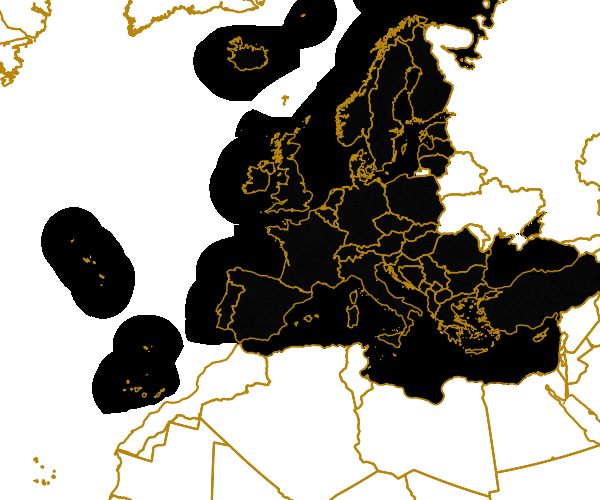
The data set combines the Corine based MAES (Mapping and Assessment of Ecosystems and their Services) ecosystem classes with the non-spatial EUNIS habitat classification for a better biological characterization of ecosystems across Europe (EEA-39). As such it represents probabilities of EUNIS habitat presence for each MAES ecosystem type. The data set aims to combine spatially explicit land cover information with non-spatially referenced habitat information to improve our knowledge about ecosystems and their distribution across Europe. The work supports the MAES process, Target 2 Action 5 of the implementation of the EU Biodiversity Strategy to 2020, established to achieve the Aichi targets of the Convention of Biological Diversity (CBD). The objective of the ecosystem data set produced by EEA and its Topic Centre ETC/SIA was to improve the biological description of land cover based ecosystem types. It represents probabilities of EUNIS habitat presence in ecosystem types at European level. Since it is not based on spatial explicit mapping the spatial and thematic accuracy is not of same quality as delineated maps. The MAES ecosystem typology differentiates three levels: whereas the level 2 of the MAES proposal follows closely the EUNIS level 1, the third level of the MAES typology corresponds to the EUNIS level 2. This level will be the base for the mapping approach.
-
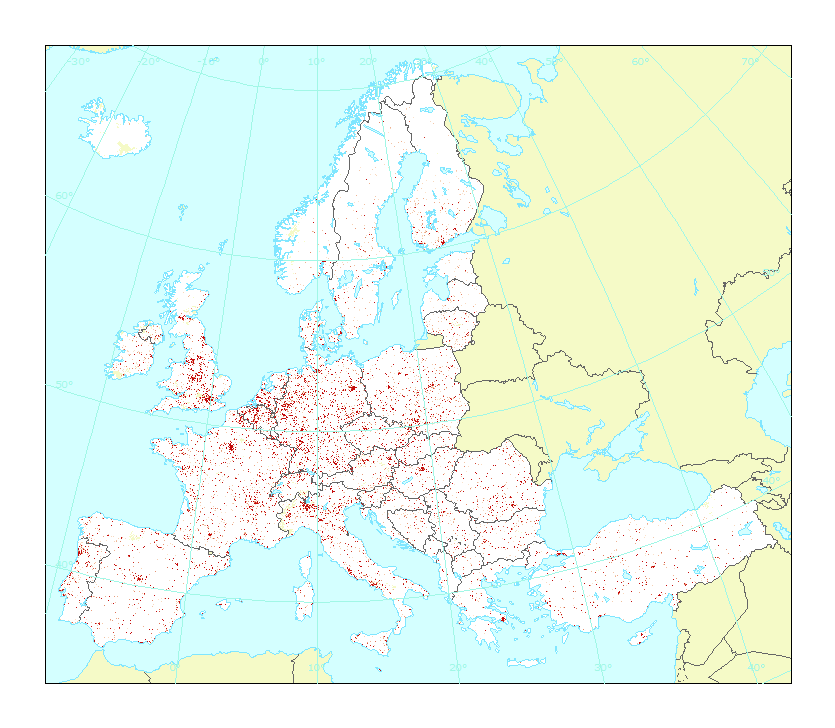
The current resource was derived from original Copernicus High Resolution Layer Imperviousness Density 2015 product for the purposes of imperviousness indicator (LSI002) calculations within the EEA LEAC CUBE environment. The dataset is also input to the imperviousness indicator itself. The high resolution imperviousness products capture the percentage and change of soil sealing. Built-up areas are characterized by the substitution of the original (semi-) natural land cover or water surface with an artificial, often impervious cover. These artificial surfaces are usually maintained over long periods of time. A series of high resolution imperviousness datasets (for the 2006, 2009, 2012 and 2015 reference years) with all artificially sealed areas was produced using automatic derivation based on calibrated Normalized Difference Vegetation Index (NDVI). This series of imperviousness layers constitutes the main status layers. They are per-pixel estimates of impermeable cover of soil (soil sealing) and are mapped as the degree of imperviousness (0-100%). Imperviousness change layers were produced as a difference between the reference years (2006-2009, 2009-2012, 2012-2015 and additionally 2006-2012, to fully match the CORINE Land Cover production cycle) and are presented 1) as degree of imperviousness change (100% - +100%), in 20m and 100m pixel size, and 2) a classified (categorical) 20m change product. The latest version (published: 15/01/2019) of 100m resolution imperviousness status layers represents a time series consistent with 100m resolution imperviousness change layers - the cell by cell difference of the degree of imperviousness status corresponds to the degree of imperviousness change. The production of the High Resolution Imperviousness products was coordinated by the European Environment Agency in the frame of the EU Copernicus programme.
-

The current resource was derived from original Copernicus High Resolution Layer Imperviousness Density 2012 product for the purposes of imperviousness indicator (LSI002) calculations within the EEA LEAC CUBE environment. The dataset is also input to the imperviousness indicator itself. The high resolution imperviousness products capture the percentage and change of soil sealing. Built-up areas are characterized by the substitution of the original (semi-) natural land cover or water surface with an artificial, often impervious cover. These artificial surfaces are usually maintained over long periods of time. A series of high resolution imperviousness datasets (for the 2006, 2009, 2012 and 2015 reference years) with all artificially sealed areas was produced using automatic derivation based on calibrated Normalized Difference Vegetation Index (NDVI). This series of imperviousness layers constitutes the main status layers. They are per-pixel estimates of impermeable cover of soil (soil sealing) and are mapped as the degree of imperviousness (0-100%). Imperviousness change layers were produced as a difference between the reference years (2006-2009, 2009-2012, 2012-2015 and additionally 2006-2012, to fully match the CORINE Land Cover production cycle) and are presented 1) as degree of imperviousness change (100% - +100%), in 20m and 100m pixel size, and 2) a classified (categorical) 20m change product. The latest version (published: 15/01/2019) of 100m resolution imperviousness status layers represents a time series consistent with 100m resolution imperviousness change layers - the cell by cell difference of the degree of imperviousness status corresponds to the degree of imperviousness change. The production of the High Resolution Imperviousness products was coordinated by the European Environment Agency in the frame of the EU Copernicus programme.
-
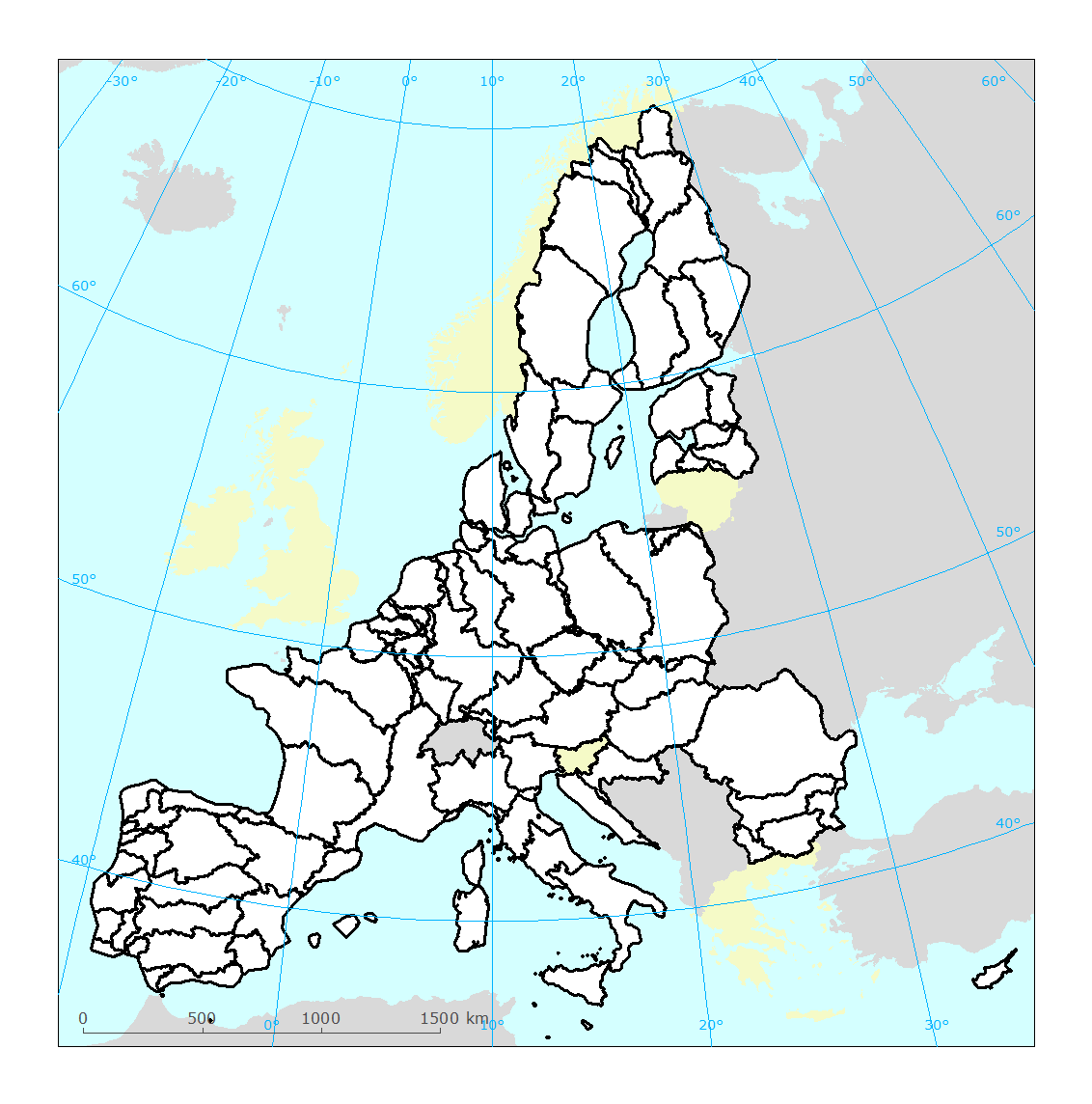
The dataset contains information on the European river basin districts delineated for the 1st River Basin Management Plans (RBMP) under the Water Framework Directive (WFD). The information was reported to the European Commission under the Water Framework Directive (WFD) reporting obligations. The dataset compiles the available spatial data related to the 1st RBMPs which were due in 2010 (hereafter WFD2010). See http://rod.eionet.europa.eu/obligations/521 for further information on the WFD2010 reporting. It was prepared to support the reporting of the 2nd RBMPs due in 2016 (hereafter WFD2016). See http://rod.eionet.europa.eu/obligations/715 for further information on the WFD2016 reporting. The data reported in WFD2010 were updated using data reported in WFD2016, whenever the spatial objects are identical in 2010 and 2016. For WFD2010 objects, some information may be missing, if the objects no longer exist in the 2nd River Basin Management Plans, and were not reported in WFD2016. This dataset updates the information published in "WISE River basin districts (RBD) - version 1.4, Jun. 2011" (http://sdi.eea.europa.eu/catalogue/srv/eng/catalog.search#/metadata/3be396a5-dded-4492-a620-f42d9f4aba5c) Relevant concepts: River basin district: The area of land and sea, made up of one or more neighbouring river basins together with their associated groundwaters and coastal waters, which is the main unit for management of river basins. River basin: The area of land from which all surface run-off flows through a sequence of streams, rivers and, possibly, lakes into the sea at a single river mouth, estuary or delta.
-

The data set combines the Corine based MAES (Mapping and Assessment of Ecosystems and their Services) ecosystem classes with the non-spatial EUNIS habitat classification (LEVEL 1) for a better biological characterization of ecosystems across Europe (EEA-39). As such it represents probabilities of EUNIS habitat presence for each MAES ecosystem type. The data set aims to combine spatially explicit land cover information with non-spatially referenced habitat information to improve our knowledge about ecosystems and their distribution across Europe. The work supports the MAES process, Target 2 Action 5 of the implementation of the EU Biodiversity Strategy to 2020, established to achieve the Aichi targets of the Convention of Biological Diversity (CBD). The objective of the ecosystem data set produced by EEA and its Topic Centre ETC/SIA was to improve the biological description of land cover based ecosystem types. It represents probabilities of EUNIS habitat presence in ecosystem types at European level. Since it is not based on spatial explicit mapping the spatial and thematic accuracy is not of same quality as delineated maps. The MAES ecosystem typology differentiates three levels: whereas the level 2 of the MAES proposal follows closely the EUNIS level 1, the third level of the MAES typology corresponds to the EUNIS level 2. This level will be the base for the mapping approach.
-

The dataset contains information on the European groundwater bodies delineated for the 2nd River Basin Management Plans (RBMP) under the Water Framework Directive (WFD). The information was reported to the European Commission under the Water Framework Directive (WFD) reporting obligations. The dataset compiles the available spatial data related to the 2nd RBMPs due in 2016 (hereafter WFD2016). See http://rod.eionet.europa.eu/obligations/715 for further information on the WFD2016 reporting. Relevant concepts: Groundwater body: 'Body of groundwater' means a distinct volume of groundwater within an aquifer or aquifers. Groundwater: All water which is below the surface of the ground in the saturation zone and in direct contact with the ground or subsoil. Aquifer: Subsurface layer or layers of rock or other geological strata of sufficient porosity and permeability to allow either a significant flow of groundwater or the abstraction of significant quantities of groundwater.
-

The data set aims to contribute to a better biological characterization of terrestrial ecosystems across Europe (EEA-39). As such it represents probabilities of EUNIS (EUropean Nature Information System) habitat presence at Level 2 (this corresponds to EUNIS level 3 for marine habitats). The map combines spatially explicit data on land cover information with non-spatially referenced habitat information of the EUNIS classification. The objective of the data set produced by EEA and its Topic Centre ETC/BD is to improve the biological description of land based ecosystem types and their spatial distribution across Europe. Since it is partly based on non-spatial explicit mapping the spatial and thematic accuracy is not of same quality as delineated maps. For terrestrial habitats the geometric and thematic accuracy is estimated in the reliability map 2012 v3.1 as secondary product. The work supports Target 2 Action 5 of the implementation of the EU Biodiversity Strategy to 2020, established to achieve the Aichi targets of the Convention of Biological Diversity (CBD). It further ad-dresses the MAES process (Mapping and Assessing of Ecosystems and their Services). The MAES ecosystem typology differentiates three levels and with certain differences follows the EUNIS classification: whereas MAES level 2 the proposal corresponds to EUNIS level 1, MAES level 3 follows closely the EUNIS level 2. A representation of MAES level 2 is contained in the reliability map as secondary product.
-
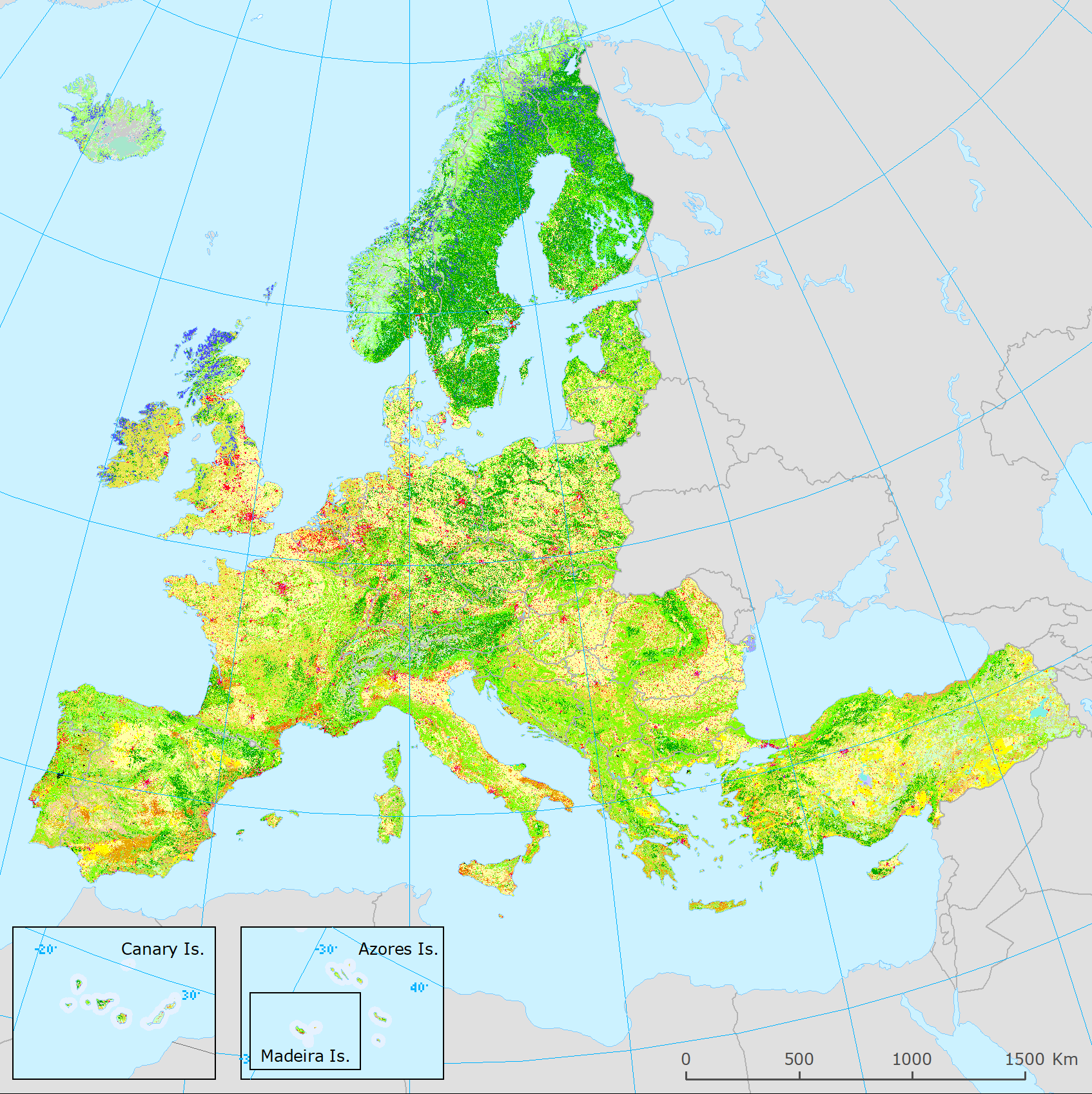
The present 100m raster dataset is the 2018 CLC status layer modified for the purpose of consistent statistical analysis in the land cover change accounting system at EEA. CORINE Land Cover (CLC) data are produced from 1986 for European (EEA member or cooperating) countries. Altogether five mapping inventories were implemented in this period, producing five status layers (CLC1990, CLC2000, CLC2006, CLC2012, CLC2018) and four CLC-Change (CLCC) layers for the corresponding periods (1990-2000, 2000-2006, 2006-2012, 2012-2018). Pan-European CLC and CLCC data are available as vector and raster products. Due to the technical characteristics of CLC and CLCC data, the evolution in CLC update methodology and in quality of input data, time-series statistics derived directly from historical CLC data includes several inconsistencies. In order to create a statistically solid basis for CLC-based time series analysis, a harmonization methodology was elaborated.
-
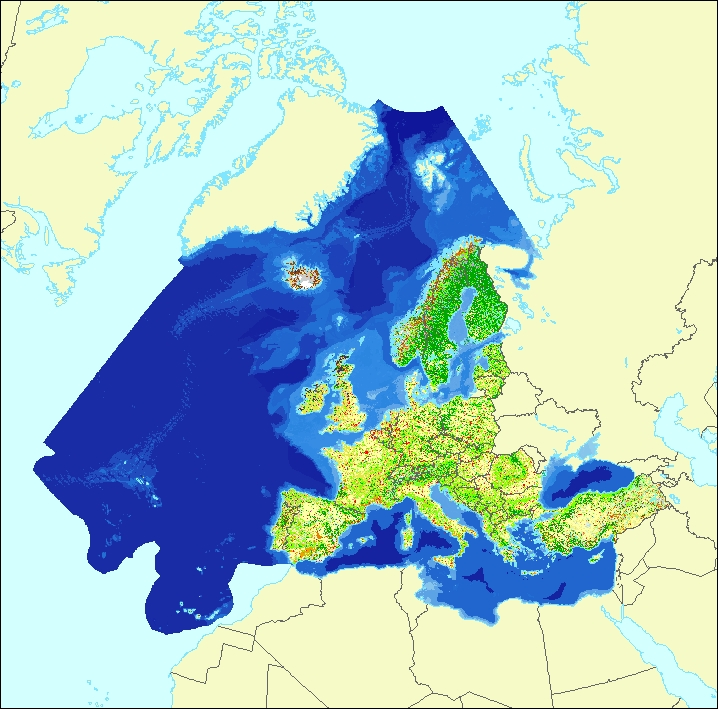
The data set aims to contribute to a better biological characterization of marine and terrestrial ecosystems across Europe (EEA-39). As such it represents probabilities of EUNIS (EUropean Nature Information System) habitat presence at Level 2 for terrestrial habitats and corresponding Level 3 for marine habitats (including information on sea ice coverage). The map combines spatially explicit data on marine bathymetry and sea-bed and land cover information with non-spatially referenced habitat information of the EUNIS classification. The objective of the data set produced by EEA and its Topic Centres ETC/BD and ETC/ULS is to improve the biological description of marine and land based ecosystem types and their spatial distribution across Europe. Since it is partly based on non-spatial explicit mapping the spatial and thematic accuracy is not of same quality as delineated maps. For terrestrial habitats the geometric and thematic accuracy is estimated in the reliability map 2012 v3.1 as secondary product. The work supports Target 2 Action 5 of the implementation of the EU Biodiversity Strategy to 2020, established to achieve the Aichi targets of the Convention of Biological Diversity (CBD). It further addresses the MAES process (Mapping and Assessing of Ecosystems and their Services). The MAES ecosystem typology differentiates three levels and with certain differences follows the EUNIS classification: whereas MAES level 2 the proposal corresponds to EUNIS level 1, MAES level 3 follows closely the EUNIS level 2. For terrestrial habitats a representation of MAES level 2 is contained in the reliability map as secondary product.
 RUC Geo-Data catalogue
RUC Geo-Data catalogue